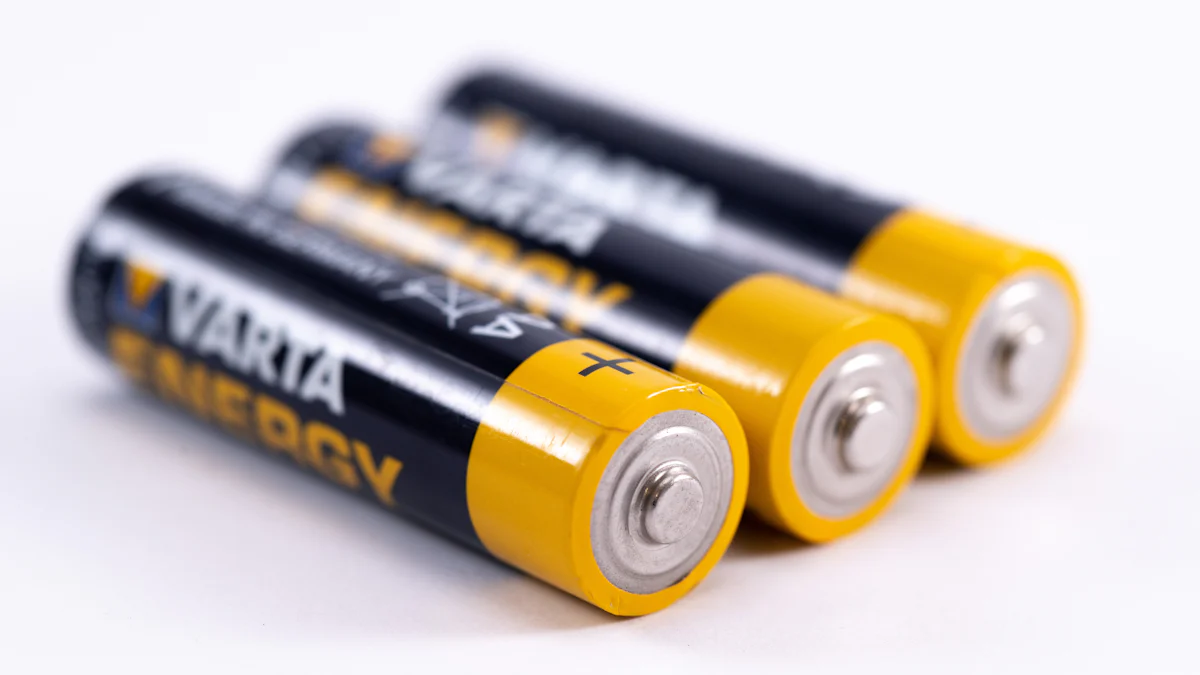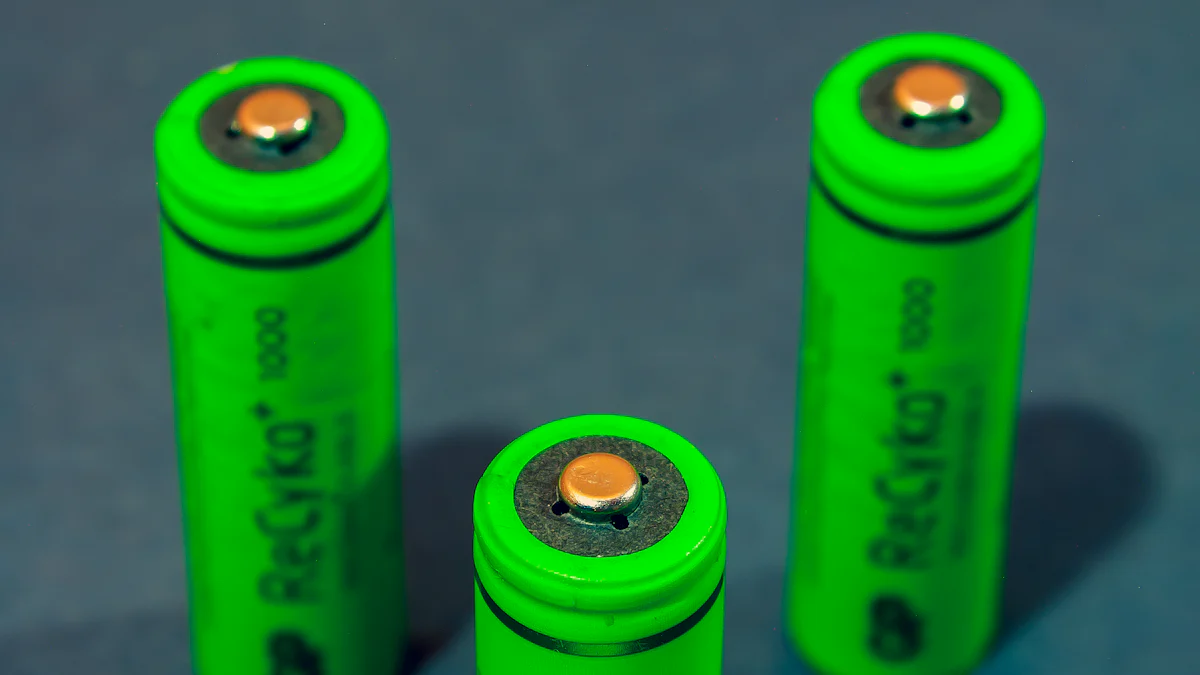
I see the alkaline battery market evolving rapidly due to increasing demand for portable power solutions. Consumer electronics, such as remote controls and wireless devices, rely heavily on these batteries. Sustainability has become a priority, driving innovation in eco-friendly designs. Technological advancements now enhance battery efficiency and lifespan, making them more reliable. Emerging economies also contribute to market growth by adopting these batteries for various applications. This dynamic shift highlights the importance of staying ahead in this competitive industry.
Key Takeaways
- The alkaline battery market is growing steadily. It is expected to grow 4-5% each year until 2025. This growth is due to demand for consumer electronics.
- Companies are focusing on sustainability. They are using eco-friendly materials and methods. This helps the environment and attracts eco-conscious buyers.
- New technology has made batteries last longer and work better. Modern alkaline batteries now work well in high-power devices. They are used in many different ways.
- Growing economies are important for market growth. As people earn more money, they want affordable and reliable energy options.
- Teamwork and research are key for new ideas. Companies invest in these to stay competitive in the battery market.
Overview of the Alkaline Battery Market
Current Market Size and Growth Projections
The alkaline battery market has shown remarkable growth in recent years. I have observed that the global demand for these batteries continues to rise, driven by their widespread use in consumer electronics and household devices. According to industry reports, the market size reached significant milestones in 2023 and is projected to grow steadily through 2025. Analysts predict a compound annual growth rate (CAGR) of around 4-5%, reflecting the increasing reliance on portable power solutions. This growth aligns with the expanding adoption of alkaline batteries in emerging economies, where affordability and reliability remain key factors.
Key Players and Competitive Landscape
Several prominent companies dominate the alkaline battery market, each contributing to its competitive landscape. Brands like Duracell, Energizer, and Panasonic have established themselves as leaders through consistent innovation and quality. I have also noticed the rise of manufacturers like Johnson New Eletek Battery Co., Ltd., which focuses on delivering reliable products and sustainable solutions. These companies invest heavily in research and development to enhance battery performance and meet evolving consumer needs. The competition fosters innovation, ensuring that the market remains dynamic and responsive to technological advancements.
Major Applications Driving Demand
The versatility of alkaline batteries makes them indispensable across various applications. I see their primary use in consumer electronics, including remote controls, flashlights, and wireless devices. Additionally, they play a crucial role in medical devices, toys, and portable tools. The growing popularity of smart home devices has further boosted demand. Alkaline batteries offer a cost-effective and long-lasting power source, making them a preferred choice for both personal and professional use. Their ability to deliver consistent performance across diverse applications underscores their importance in today’s energy landscape.
Key Trends in the Alkaline Battery Market

Rising Demand in Consumer Electronics
I have observed a significant surge in the use of alkaline batteries in consumer electronics. Devices like wireless keyboards, gaming controllers, and smart remotes rely on these batteries for consistent performance. The growing popularity of portable gadgets has further fueled this demand. Consumers prioritize reliability and affordability, making alkaline batteries a preferred choice. Their ability to deliver steady power output ensures optimal functionality for these devices. I believe this trend will continue as technology evolves and more households adopt smart devices.
Sustainability and Eco-Friendly Innovations
Sustainability has become a critical focus in the alkaline battery market. Manufacturers are now exploring eco-friendly materials and production methods to reduce environmental impact. I have noticed an increasing shift toward mercury-free and recyclable batteries. These innovations align with global efforts to promote green energy solutions. Companies like Johnson New Eletek Battery Co., Ltd. emphasize sustainable practices, ensuring their products meet modern environmental standards. This commitment to eco-friendliness not only benefits the planet but also appeals to environmentally conscious consumers.
Technological Advancements in Battery Efficiency
Advancements in technology have revolutionized the performance of alkaline batteries. I see manufacturers investing heavily in research to enhance energy density and lifespan. Modern alkaline batteries now last longer and perform better under high-drain conditions. These improvements make them suitable for demanding applications, such as medical devices and high-tech tools. I believe this progress reflects the industry’s dedication to meeting consumer expectations. By prioritizing efficiency, the alkaline battery market continues to evolve and maintain its relevance in a competitive landscape.
Growth in Emerging Economies and Regional Markets
I have noticed that emerging economies play a pivotal role in driving the growth of the alkaline battery market. Countries in Asia-Pacific, Latin America, and Africa are experiencing rapid industrialization and urbanization. This transformation has increased the demand for reliable and affordable energy solutions. Alkaline batteries, known for their cost-effectiveness and long-lasting performance, have become a preferred choice in these regions.
In Asia-Pacific, nations like India and China lead the way. Their growing middle-class population and rising disposable incomes have fueled the adoption of consumer electronics. Devices such as remote controls, toys, and portable tools rely heavily on alkaline batteries. I have observed that local manufacturers in these regions are also expanding their production capacities to meet the surging demand.
Latin America has shown similar trends. Countries like Brazil and Mexico are witnessing a surge in the use of alkaline batteries for household and industrial applications. The region’s focus on infrastructure development and technological advancements has further boosted the market. Retailers and distributors in these areas are capitalizing on the growing demand by offering a wide range of battery options.
Africa, with its expanding energy needs, presents another promising market. Many households in rural areas depend on alkaline batteries for powering essential devices like flashlights and radios. I believe this reliance will continue to grow as electrification efforts progress across the continent.
Regional markets also benefit from strategic partnerships and investments. Companies like Johnson New Eletek Battery Co., Ltd. are well-positioned to cater to these emerging markets. Their commitment to quality and sustainable practices aligns with the needs of these regions. By focusing on affordability and reliability, the alkaline battery market is poised for significant growth in these economies.
Challenges Facing the Alkaline Battery Market
Competition from Alternative Battery Technologies
I have observed that the rise of alternative battery technologies poses a significant challenge to the alkaline battery market. Lithium-ion batteries, for instance, dominate applications requiring rechargeable solutions. Their high energy density and lightweight design make them ideal for smartphones, laptops, and electric vehicles. Nickel-metal hydride (NiMH) batteries also compete in specific niches, offering rechargeable options for household devices. These alternatives often appeal to consumers seeking long-term cost savings and reduced waste. While alkaline batteries remain a reliable choice for single-use applications, the growing preference for rechargeable options could impact their market share.
Rising Costs of Raw Materials
The cost of raw materials directly affects the production and pricing of alkaline batteries. I have noticed that materials like zinc, manganese dioxide, and potassium hydroxide have experienced price fluctuations due to supply chain disruptions and increased global demand. These rising costs create challenges for manufacturers striving to maintain competitive pricing without compromising quality. Companies must navigate these economic pressures while ensuring their products remain accessible to consumers. Efficient resource management and strategic sourcing have become essential for sustaining profitability in this competitive landscape.
Environmental Concerns and Recycling Limitations
Environmental concerns present another hurdle for the alkaline battery industry. I have seen growing awareness about the environmental impact of disposable batteries. Improper disposal can lead to soil and water contamination, raising concerns among eco-conscious consumers. Although alkaline batteries are now mercury-free, recycling remains a challenge. The process is often costly and complex, limiting widespread adoption. Manufacturers must address these issues by investing in sustainable practices and promoting proper disposal methods. Educating consumers about recycling options can also help mitigate environmental risks and enhance the industry’s reputation.
Opportunities in the Alkaline Battery Market

Increased R&D Investments and Innovation
I see research and development as a cornerstone for growth in the alkaline battery market. Companies are allocating significant resources to enhance battery performance and sustainability. For instance, advancements in energy density and leak-proof designs have made modern batteries more efficient and reliable. I believe these innovations cater to the growing demand for high-performance batteries in consumer electronics and industrial applications. Additionally, R&D efforts focus on reducing environmental impact by developing mercury-free and recyclable batteries. This commitment to innovation not only strengthens the market but also aligns with global sustainability goals.
Strategic Partnerships and Industry Collaborations
Collaborations between manufacturers, suppliers, and technology firms create new opportunities in the alkaline battery market. I have observed that partnerships often lead to the development of cutting-edge technologies and streamlined production processes. For example, manufacturers can work with material suppliers to secure high-quality raw materials at competitive prices. Joint ventures also enable companies to expand their market reach by leveraging each other’s distribution networks. I believe these collaborations foster a win-win environment, driving growth and ensuring that businesses remain competitive in a dynamic industry.
Expanding Applications in New Sectors
The versatility of alkaline batteries opens doors to applications in emerging sectors. I see growing interest in using these batteries for renewable energy storage and smart grid systems. Their reliability and cost-effectiveness make them suitable for backup power solutions in residential and commercial settings. Additionally, the healthcare industry increasingly relies on alkaline batteries for portable medical devices. I believe this trend will continue as technology evolves and new use cases emerge. By exploring these opportunities, the alkaline battery market can diversify its applications and sustain long-term growth.
The alkaline battery market continues to evolve, driven by key trends that I believe will shape its future. Rising demand for consumer electronics, sustainability-focused innovations, and advancements in battery efficiency stand out as pivotal factors. These trends highlight the industry’s commitment to meeting modern energy needs while addressing environmental concerns.
I see sustainability and technology as the cornerstones of this growth. Manufacturers are prioritizing eco-friendly solutions and investing in cutting-edge research to enhance battery performance. This focus ensures the market remains competitive and aligned with global expectations.
Looking ahead, I expect the alkaline battery market to achieve steady growth through 2025. Emerging economies, expanding applications, and strategic collaborations will likely fuel this momentum. By embracing innovation and sustainability, the industry is well-positioned to meet the challenges and opportunities of the future.
FAQ
What are alkaline batteries, and how do they work?
Alkaline batteries use zinc and manganese dioxide as electrodes. They generate power through a chemical reaction between these materials and an alkaline electrolyte, usually potassium hydroxide. This design ensures consistent energy output, making them reliable for various devices like remotes, toys, and flashlights.
Why are alkaline batteries popular in consumer electronics?
I believe their popularity stems from their affordability, long shelf life, and reliable performance. These batteries provide steady power, making them ideal for devices like wireless keyboards, gaming controllers, and medical tools. Their widespread availability further enhances their appeal to consumers worldwide.
How do manufacturers address environmental concerns with alkaline batteries?
Manufacturers now focus on mercury-free designs and recyclable materials. Companies like Johnson New Eletek Battery Co., Ltd. prioritize sustainable practices, ensuring their products meet modern environmental standards. Educating consumers about proper disposal and recycling options also helps mitigate environmental risks.
Are alkaline batteries suitable for high-drain devices?
Yes, modern alkaline batteries perform well under high-drain conditions. Technological advancements have improved their energy density and lifespan. This makes them suitable for demanding applications, including medical devices and high-tech tools, where consistent and reliable power is essential.
What role do emerging economies play in the alkaline battery market?
Emerging economies drive significant growth due to rising industrialization and urbanization. Countries like India, China, and Brazil see increased demand for affordable and reliable energy solutions. Alkaline batteries meet these needs, making them a preferred choice in these regions for household and industrial applications.
Post time: Jan-13-2025




